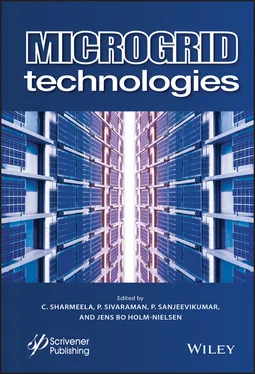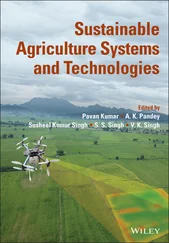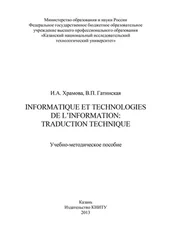3 The system with GUPFC and without fuel cell shows improvement in load voltage profile during 27a fault in intentional islanding condition but with the non-islanded condition, the load voltage deviation in this system matches the system without GUPFC and without fuel cell.
4 The system with GUPFC and with fuel cell shows improved results and lower percentage load voltage deviation from rated load voltage during the fault. The percentage deviation of the load voltage is minimum in intentional islanded system operation compared to the non-islanded system.
5 The system with active GUPFC i.e. GUPFC embedded with the fuel cell shows minimum percentage load voltage deviation from its rated value during the fault on the system. The most probable fault, single phase to ground fault, has minimum percentage load voltage deviation as compared to three-phase to ground fault during non-islanding and intentional islanding conditions.
6 The graphs in Figures 2.23and 2.24illustrate the deviation of load voltage from rated value under different network situations.
7 The load voltage in ‘without GUPFC and without fuel cell’ and ‘with GUPFC and without fuel cell’ shows maximum deviation from rated value.
8 The load voltage in ‘without GUPFC and with fuel cell’ shows medium deviation from rated value.
9 The system in ‘with GUPFC and with fuel cell’ has a lower deviation.
10 The load voltage in ‘with active GUPFC’ has the lowest deviation from the rated load voltage.
Due to fault on any component of the power system, voltage profile is affected; and hence power stability and quality deteriorate. The improvement in stability is not possible only by adding distributed generators (DG) in the system, but additional power flow controllers are also required to support it. With the help of FACTS controllers like GUPFC, the usable capacity of the transmission line improves and it can be flexibly loaded with larger limits depending on the system conditions. GUPFC fails to control power flow when capacitor charging power becomes unavailable due to fault. If GUPFC is present in the intentionally separated sub-system, then the charging of the capacitor is an additional load on the sub-system, which becomes sensitive due to the small power number (MW/Hz). The performance of GUPFC depends on the amount of charge on its capacitor, which depends on the connection to the energy source. It is, therefore, necessary that a generation embedded with the GUPFC system is needed.
2.6 Appendix General Test System
The part of MAC 24 system considered a comprehensive test system. The original MAC 24 system diagram is shown in Figure 2.25. It is available in MiPower software as a standard test system. Table 2.3shows network parameters.
2.6.1 IEEE 9 Bus Test System
The nine bus test system referred from MATPOWER program. After solving DC load flow for the test system, the simulation model obtained using graph theory. The bus numbers 4, 6, 8 were deleted from the simulation model as these buses were neither connected to generator nor to load. The original nine bus system and its data shown in Figure 2.26. Table 2.4shows the branch data of IEEE 9 bus system.
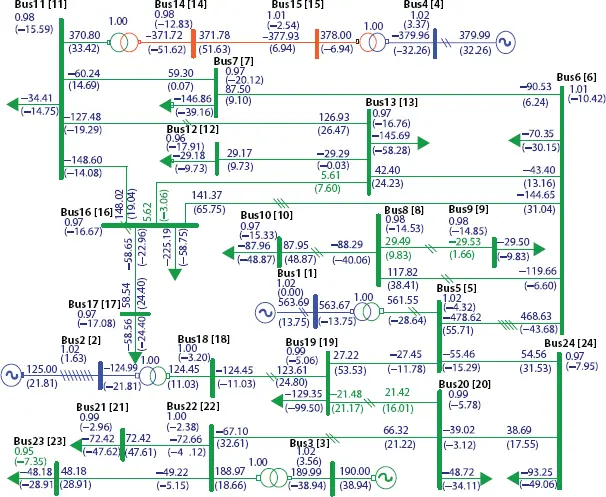
Figure 2.25 MAC 24 network diagram.
Table 2.3 MAC 24 network parameters.
| From |
To |
R (pu) |
B (pu) |
B/2 (pu) |
| BUS15 |
BUS14 |
0.00430 |
0.04770 |
0.63700 |
| BUS7 |
BUS11 |
0.02444 |
0.12226 |
0.10272 |
| BUS12 |
BUS13 |
0.01321 |
0.06608 |
0.05552 |
| BUS13 |
BUS11 |
0.00314 |
0.01570 |
0.05275 |
| BUS13 |
BUS16 |
0.00578 |
0.02891 |
0.02429 |
| BUS16 |
BUS11 |
0.00247 |
0.01239 |
0.04164 |
| BUS16 |
BUS17 |
0.00248 |
0.01239 |
0.01041 |
| BUS5 |
BUS6 |
0.00450 |
0.02251 |
0.30260 |
| BUS6 |
BUS7 |
0.03716 |
0.18586 |
0.15616 |
| BUS6 |
BUS13 |
0.05169 |
0.25856 |
0.21723 |
| BUS6 |
BUS16 |
0.01530 |
0.07655 |
0.57882 |
| BUS6 |
BUS8 |
0.01239 |
0.06195 |
0.20822 |
| BUS8 |
BUS9 |
0.00363 |
0.01817 |
0.06107 |
| BUS8 |
BUS10 |
0.00330 |
0.01652 |
0.05552 |
| BUS18 |
BUS19 |
0.00537 |
0.02685 |
0.09022 |
| BUS19 |
BUS5 |
0.01263 |
0.06319 |
0.21237 |
| BUS19 |
BUS20 |
0.01131 |
0.05658 |
0.19016 |
| BUS20 |
BUS24 |
0.01982 |
0.09913 |
0.08328 |
| BUS24 |
BUS5 |
0.02494 |
0.12473 |
0.10480 |
| BUS22 |
BUS23 |
0.03633 |
0.18173 |
0.15269 |
| BUS22 |
BUS20 |
0.01734 |
0.08674 |
0.29149 |
| BUS22 |
BUS21 |
0.00330 |
0.01652 |
0.01388 |
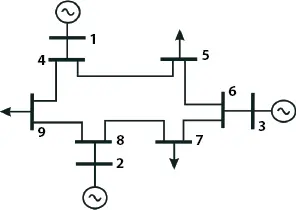
Figure 2.26 IEEE 9 bus test system.
Table 2.4 IEEE 9 bus test system branch data.
| fBus |
tBus |
r |
x |
B |
z |
| 1 |
4 |
0 |
0.0576 |
0 |
0.0576 |
| 4 |
5 |
0.017 |
0.092 |
0.158 |
0.0935 |
| 5 |
6 |
0.039 |
0.17 |
0.358 |
0.17 |
| 3 |
6 |
0 |
0.0586 |
0 |
0.0586 |
| 6 |
7 |
0.0119 |
0.1008 |
0.209 |
0.1015 |
| 7 |
8 |
0.0085 |
0.072 |
0.149 |
0.0725 |
| 8 |
2 |
0 |
0.0625 |
0.25 |
0.0625 |
| 8 |
9 |
0.032 |
0.161 |
0.306 |
0.1641 |
| 9 |
4 |
0.01 |
0.085 |
0.176 |
0.0855 |
1. Hingorani, N.G. and Gyugyi, L., Understanding FACTS , IEEE Press and John Wiley Inc., 1 ed., 2000.
2. Basu, S., Recent Trends in Fuel Cell Science and Technology , New Delhi, India: Anamaya Publishers, Copublished by Springer, 2007.
3. C.E.A. India, Report on review of performance of thermal power stations 2009–10 , p. VII, September 2010.
4. Secretariat, Renewable energy technologies: Cost analysis series—hydropower , IRENA working paper, vol. 1, June 2012.
5. Nayak, Energetica India: cost economics of solar kwh , January/February 2012.
6. Ignacio, J., Zamora, I., Martin, J.S., Aperribay, V. and Egua, P., Hybrid fuel cell technologies for electrical microgrids, Electrical Power System Research , vol. 80, pp. 993–1005, September 2010.
7. E.T.S. Inc., Fuel Cell Handbook , U.S. Department of Energy, seventh ed., 2004.
8. Yoon, K.H., Jang, J.H. and Cho, Y.S., Impedance characteristics of a phosphoric acid fuel cell, Journal of Materials Science , vol. 17, pp. 1755–1758, 1998.
Читать дальше
